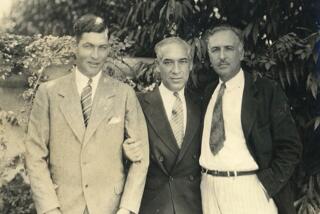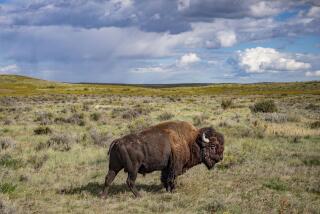Revered White Buffalo Draws Pilgrims to Wisconsin Farm
- Share via
JANESVILLE, Wis. — Many summers past, when buffalo roamed the plains and grass grew tall beneath the sun, a beautiful woman appeared to the Lakota. She was dressed in white buckskin and carried a wooden pipe. The pipe would bring peace, she said, if they lived good lives.
She stayed with the tribe for four days. Upon leaving, she paused and rolled on the ground, rising as a great black buffalo. She rolled again, turning red, and again, turning yellow, and one last time, turning white. Then she disappeared into the sunset.
The sacred pipe is handed down from generation to generation. And so is the prophecy: that the white buffalo will return someday, that she will bring world peace.
*
Stomping and grunting, the herd thunders around the corral, kicking up a dust cloud, threatening to charge the fence. The workers shout over the din, yanking on pulleys, poking with long wooden sticks, pushing and cursing as they force the dark, shaggy beasts into a series of pens.
One animal stands serene. She is a lighter color than the others; her mane has a blondish tint, as though sprinkled with powder. Her huge brown eyes are soulful and sweet.
“Easy, girl, c’mon, girl,” the farmer calls, his tone soothing, reverent. “Just one last time, girl.”
No other buffalo is caressed this way. No other buffalo can coax kindness out of the gruff, acerbic heart of Dave Heider.
This 900-pound beast is special. In the five years since her birth, more than 250,000 pilgrims have flocked to Heider’s farm just to see her.
They come from around the world, American Indians and tourists, rock stars and farmers, priests and politicians. They bring food and gifts--beadwork, tobacco, teddy bears, sweetgrass. They bring babies and prayers and tears. The Dalai Lama has traipsed down the long gravel driveway to the meadow at the top of the hill. So has the governor. To those who leave offerings at her gate, this buffalo is sacred. In her first year, she changed color four times: black, red, yellow and brown, fulfilling the prophecy.
She was born snow white. Her name is Miracle.
Dave Heider discovered Miracle on his morning rounds on Aug. 20, 1994. At first he thought the light was playing tricks on him. Buffalo calves are normally cinnamon, turning darker as they grow. Heider had never seen anything like this fluffy white creature that struggled to her feet and tottered after her mother.
“Man,” he whistled. “I’m rich.”
Heider is 50 years old, a native of Janesville, a town of about 60,000 people, 40 miles south of Madison. He drives a truck for the Rock County highway department, runs a farm on the side. Reared on hard work and hard luck, he got into the buffalo business on a whim in 1990 and now has a herd of about 60. Most are raised for slaughter.
Five years ago, Heider knew nothing about ancient prophecies or sacred symbols. He’d never met an American Indian. But he knew that any animal born pure white was a prize, one that could fetch a fabulous price.
“She’s our little miracle,” Val Heider said, and so the calf was named.
The couple argue over many things, and Miracle was no exception. Dave admits that, early on, all he saw was dollar signs. Val saw something else, something in Miracle’s eyes.
“They’re different,” she says. “They’re softer.”
The local newspaper ran a story, and soon calls--and offers--were pouring in. Two days after the calf was born, the first pilgrims arrived, a group of American Indians sent as scouts to check the authenticity of the white buffalo calf.
The Heiders watched in amazement as they removed their shoes, a mark of respect before walking on sacred ground. They prayed before Miracle and pinned web-shaped dream-catchers to her gate.
A short time later, the Heiders received a phone call from chief medicine man Floyd Hand of the Sioux nation in Pine Ridge, S.D.
“Do not sell the sacred white buffalo calf,” he warned. “You have been chosen to be her guardians.”
As Dave listened skeptically, Hand made a chilling prediction. Miracle’s father would die within days, laying down its life for the calf.
Two days later the Heiders’ prized bull, Marvin, died suddenly from an obstruction in his stomach.
The couple stopped arguing. Since then, they have had no doubts that Miracle will remain with them for the rest of her life.
“It hasn’t been easy,” Val says with a sigh.
“It sure hasn’t,” Dave growls.
In the last five years their modest two-story home on South River Road has become a shrine, marked by a small stone buffalo in the front yard and a 50-foot white Styrofoam one in the back. Rising from its back is a naked silver woman, reaching with a spear toward the sky.
The Heiders have turned down offers from theme parks and tribes. Rock singer Ted Nugent, who had a late 1970s hit called “Great White Buffalo,” wanted to buy her. So did Ted Turner. David Letterman wanted to fly her to New York to appear on his late-night show.
“Miracle doesn’t travel,” Val politely told the television folks. “People travel to see her.”
In 1994 a woman flew from Australia just to spend Christmas with Miracle, flying home the next day. One man arrived in a Cadillac claiming to be Jesus.
One day, a badly burned woman walked up the drive, clutching a photograph of her two young sons. They had died in a house fire days earlier. Without saying a word, she left the photograph by Miracle’s gate. It is now ensconced in a glass case at a little museum on the farm, along with thousands of feathers and pipes and tobacco pouches, and the Dalai Lama’s scarf.
“No matter what people have suffered, Miracle seems to bring them comfort,” Val says. “People say they feel an energy coming from her pasture.”
But some worry about all that energy, and the effect on Miracle herself. Hand, the Sioux medicine man, believes Miracle’s recent illness is an omen. Things must change, he says, if the prophecy of peace is to be fulfilled. For if Miracle dies prematurely, it will mean Armageddon.
In particular, Hand objects to the selling of trinkets--buffalo earrings and socks and T-shirts--at a little gift shop on the farm.
“Everyone wants something from her,” says Hand, who visits Miracle every year on her birthday. “By commercializing her holiness, they are drawing a lot of energy force from her instead of giving her energy by praying for her well-being. She is in great pain.”
Hand says he wept with Miracle when he visited the farm last summer.
Around the same time, the Heiders noticed that Miracle was losing weight, becoming listless. She stopped eating. She started limping.
Veterinarian Tom Williams discovered an abscess in her right hind foot. If the infection had spread, it could have killed her.
“Any other buffalo would have been freezer meat,” Dave Heider said. “But Miracle had to be saved.”
Not many vets have operated on a buffalo, especially not a sacred one. The biggest worry wasn’t so much surgery as sedation. In rare cases where buffalo have been given anesthesia, the animals often don’t wake up.
The surgery took place in late September and lasted about 35 minutes. Williams cut out the abscess, drained the wound, treated it with oakum and pine tar and bound the foot in an Ace bandage. It wasn’t until later that Val noticed the shaved patch on Miracle’s neck, where Williams had inserted the needle.
The hairs on the patch were white.
There have been other white buffalo, including the famous Big Medicine, which became a tourist attraction at the National Bison Range in Montana in the 1930s. He died in 1959 at the age of 36.
According to the National Bison Assn., the reemergence of buffalo herds inevitably means more white calves will be born. Once almost extinct, there are now about 150,000 buffalo in North America. Several other white calves have been reported since Miracle’s birth, including one in Michigan. Still, the odds are considered one in millions.
The fact that Miracle has changed color four times simply reinforces her apocalyptic status for pilgrims. They believe that if she survives to old age--buffalo life expectancy is about 30--she will turn white again, heralding world peace.
“Growing up, the story of the white buffalo was just part of family life,” said Dr. JoAllyn Archambault, director of the American Indian program at the Smithsonian Institution. A member of the Standing Rock Sioux tribe of North Dakota, Archambault made her own pilgrimage to Miracle shortly after the calf’s birth. As an American Indian, she said, she was moved to tears and to prayer. As an anthropologist, she was overwhelmed by the numbers of people, and the kinds of people, flocking to Miracle’s fence.
They still come daily, busloads in the summer, a steady trickle in winter. And the offerings keep piling up. Every month or so, Dave Heider selects a few for the museum and burns the rest--as instructed by elders.
“For me, it’s like going to church,” said John Graf, a local man who visits Miracle a couple times a week. “It’s not like I have an epiphany at this fence. It just seems appropriate to honor a sacred symbol.”
But Miracle has meant more than a symbol. She has been a boon for the local economy, whose businesses have prospered from her followers. And she has irrevocably changed the lives of the Heiders, who have been honored in American Indian ceremonies as guardians of the sacred buffalo. Val gave up her two cleaning jobs to help on the farm, which includes llamas, horses and pygmy goats. Her parents work in the gift shop. The Heiders’ three grown children help out too.
They charge no fee to see Miracle, but many visitors contribute to a trust fund set up in the buffalo’s name.
“You watch all these people standing here for hours, and you see how she affects them,” Dave says, leaning over Miracle’s fence. “It makes you look at things a little differently, makes you not take things for granted.”
Even as he speaks, another visitor arrives.
Annette Blair walks slowly to the fence, eyes brimming with tears. Miracle snorts at the trough, sucking up great mouthfuls of feed, oblivious to yet another trembling pilgrim.
Blair has traveled from Minnesota, and she can hardly believe she is standing so close. Her fingers reach through the wire mesh an inch from the buffalo’s head. Miracle pulls away sharply. For a moment they lock eyes, the worshiper and the worshiped.
“Thank you,” Blair whispers. “Thank you for letting me be here.”
Tears streaming down her face, she walks back down the drive. “Mitakuye Oyasin,” she calls after her, a traditional greeting meaning “all my relatives” or “everything is connected.”
Legend says it was first spoken by the white buffalo woman.
More to Read
Sign up for The Wild
We’ll help you find the best places to hike, bike and run, as well as the perfect silent spots for meditation and yoga.
You may occasionally receive promotional content from the Los Angeles Times.






